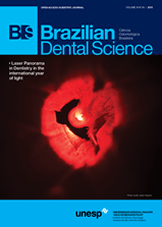Long-term dental follow-up in hematological stem cells transplantation children
DOI:
https://doi.org/10.14295/bds.2015.v18i4.1196Abstract
Objective: The aim of this paper is to update the current published content about the craniofacial long-term development disturbances of childhood hematopoietic stem-cell transplantation (HSCT) and the preparative regimens for the onco-hematological malignancies treatments. Material and Methods: Two authors independently reviewed the published articles about long-term effects of childhood HSCT that fitted in to predetermined inclusion/exclusion criteria: clear definition of exposure or intervention, standard outcomes measurement and appropriate statistical analysis. Results: Twelve papers matched all the previous established eligibility criteria and were included in this review. The children’s age at HSCT were related to a higher risk of dental development disturbances, such as agenesis, dental hypoplasia, root stunting, crown-root proportion alterations, and microdontia. Craniofacial vertical growth was impaired in the irradiated patients without antero-posterior or latero-lateral impairment. Temporomandibular joint dysfunction was found to be more prevalent in the patients who was diagnosed with graft-versus-host disease. Conclusion: The late effects of craniofacial development disturbances leads to several aesthetic and functional impairment, periodontal bone resorption with consequent impairment of chewing ability, and risk of early tooth loss often associated with life’s quality impairment. Further investigations should be performed to provide accurate information for patients, parents and health care professionals.
Keywords: Dental development. Craniofacial growth. Bone marrow transplantation. Hematopoietic stem-cell transplantation. Chemotherapy. Radiotherapy.
Downloads
Downloads
Published
How to Cite
Issue
Section
License
Brazilian Dental Science uses the Creative Commons (CC-BY 4.0) license, thus preserving the integrity of articles in an open access environment. The journal allows the author to retain publishing rights without restrictions.
=================




























